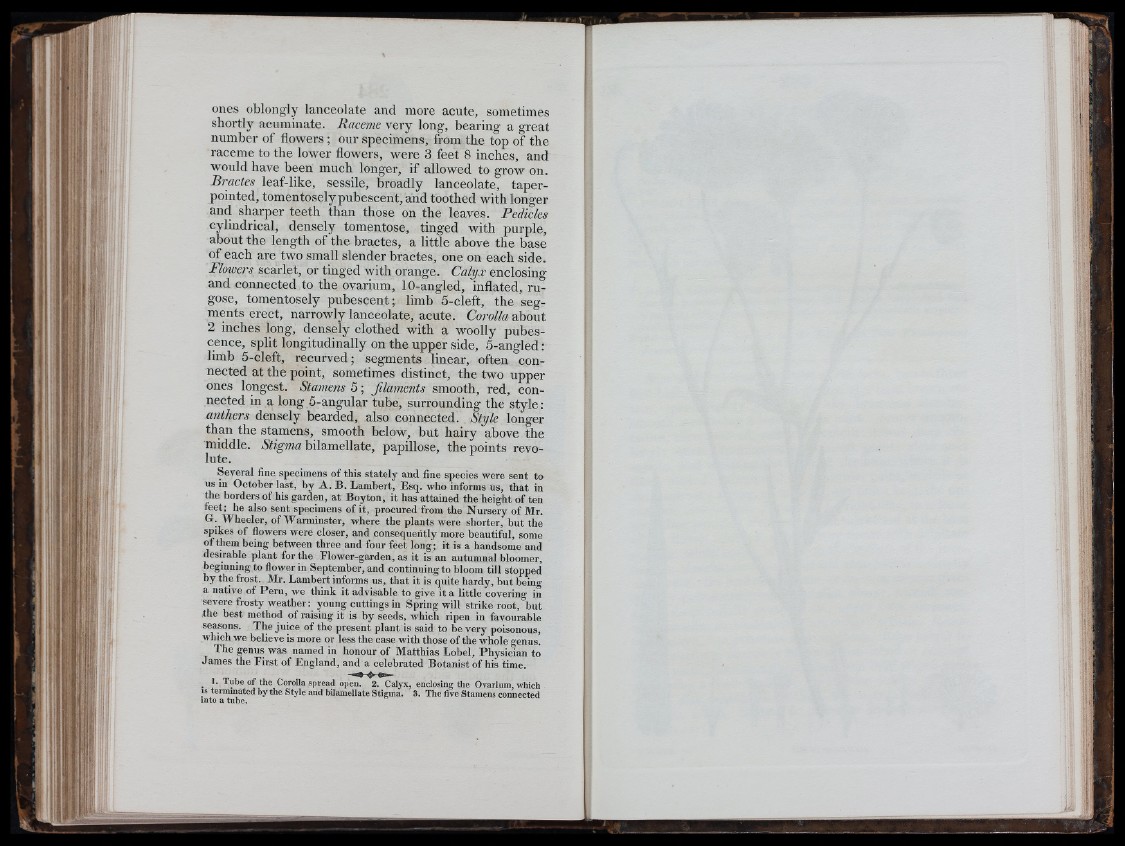
i'i,
)■ '
ones oblongly lanceolate and more acute, sometimes
shortly acuminate. Raceme very long, bearing a great
number of flowers; our specimens, from the top of the
raceme to the lower flowers, were 3 feet 8 inches, and
would have been much longer, if allowed to grow on.
Bractes leaf-like, sessile, broadly lanceolate, taper-
pointed, tomentosely pubescent, and toothed with longer
and sharper teeth than those on the leaves. Pedicles
cylindrical, densely tomentose, tinged with purple,
about the length of the bractes, a little above the base
of each are two small slender bractes, one on each side.
Flowers scarlet, or tinged with orange. Calyx enclosing
and connected to the ovarium, 10-angied, inflated, ru gose,
tomentosely pubescent; limb 5-cleft, the segments
erect, narrowly lanceolate, acute. Corolla about
2 inches long, densely clothed with a woolly pubescence,
split longitudinally on the upper side, 5-angled:
limb 5-cleft, recurved; segments linear, often connected
at the point, sometimes distinct, the two upper
ones longest. Stamens 5 ; Jilaments smooth, red, connected
in a long 5-angular tube, surrounding the s ty le :
anthers densely bearded, also connected. Style longer
than the stamens, smooth below, bu t hairy above the
middle. Arig-ra« bilamellate, papillose, the points revolute.
Several fine specimens of this stately and fine species were sent to
us in October last, by A. B. Lambert, Esq. who informs us, that in
the borders of his garden, at Boyton, it has attained the height of ten
feet; he also sent specimens of it, procured from the Nursery of Mr.
G. Wheeler, of Warminster, where the plants were shorter, but the
spikes of flowers were closer, and consequently more beautiful, some
of them being between three and four feet long; it is a handsome and
desirable plant for the Flower-garden, as it is an autumnal bloomer,
beginning to flower in September, and continuing to bloom till stopped
by the frost. Mr. Lambert informs us, that it is quite hardy, but being
a native of Pe ru , we think it advisable to give it a little covering in
severe frosty weather: young cuttings in Spring will strike root, but
the best method of raising it is by seeds, which ripen in favourable
seasons. The juice of the present plant is said to be very poisonous,
which we believe is more or less the case with those of the whole genus.
The genus was named in honour of Matthias Lobel, Physician to
James the First of England, and a celebrated Botanist of his time.
_ 1. Tube o f the Corolla spread open. 2. Calyx, enclosing the Ovarium, which
IS terminated by the Style and bilamellate Stigma. 3. The five Stamens connected
into a tube.